Graphene-Based Impregnation into Polymeric Coating for Corrosion Resistance
Abstract
1. Introduction
2. Preparation of Graphene and Its Derivatives
2.1. Preparation Methods of Graphene and Its Derivatives for Polymer Composites
2.1.1. Solution Mixing
2.1.2. In Situ Polymerisation
2.1.3. Electrochemical Reaction
2.1.4. Layer-by-Layer (LbL) Assembly
2.1.5. Melt Blending
3. Incorporation of Graphene and Its Derivatives into Polymer Composites
3.1. Graphene/Polyaniline Composites
3.2. Graphene Oxide–Polymer Bilayer Coating
3.3. Graphene–Epoxy Powder Coating
3.4. GO Modified with Polyamide–Epoxy/Zn Coating
3.5. Graphene/Polyeugenol Composite
3.6. Poly(m-Phenylenediamine)-Encapsulated Graphene
3.7. GO-Polyethylene Imine-Polyacrylic Composite
4. Overview of Functionalised Graphene in Polymer Composites
5. Conclusions
6. Challenges and Future Perspectives
Author Contributions
Funding
Data Availability Statement
Conflicts of Interest
References
- Koch, G. 1—Cost of corrosion. In Trends in Oil and Gas Corrosion Research and Technologies; Woodhead Publishing Series in Energy; El-Sherik, A.M., Ed.; Woodhead Publishing: Boston, MA, USA, 2017; pp. 3–30. [Google Scholar]
- Kumar Gupta, R.; Malviya, M.; Verma, C.K.; Gupta, N.A.; Quraishi, M. Pyridine-based functionalized graphene oxides as a new class of corrosion inhibitors for mild steel: An experimental and DFT approach. RSC Adv. 2017, 7, 39063–39074. [Google Scholar]
- Sabiha, M.; Kerroum, Y.; El Hawary, M.; Boudalia, M.; Bellaouchou, A.; Hammani, O.; Amin, H.M.A. Investigating the Adsorption and Corrosion Protection Efficacy and Mechanism of Marjoram Extract on Mild Steel in HCl Medium. Molecules 2025, 30, 272. [Google Scholar] [CrossRef] [PubMed]
- Boutoumit, A.; Elhawary, M.; Bellaouchou, A.; Boudalia, M.; Hammani, O.; José Garcia, A.; Amin, H.M.A. Electrochemical, Structural and Thermodynamic Investigations of Methanolic Parsley Extract as a Green Corrosion Inhibitor for C37 Steel in HCl. Coatings 2024, 14, 783. [Google Scholar] [CrossRef]
- Najem, A.; Campos, O.S.; Girst, G.; Raji, M.; Hunyadi, A.; García-Antón, J.; Bellaouchou, A.; Amin, H.M.A.; Boudalia, M. Experimental and DFT Atomistic Insights into the Mechanism of Corrosion Protection of Low-Carbon Steel in an Acidic Medium by Polymethoxyflavones from Citrus Peel Waste. J. Electrochem. Soc. 2023, 170, 093512. [Google Scholar]
- Singh Raman, R.K.; Chakraborty Banerjee, P.; Lobo, D.E.; Gullapalli, H.; Sumandasa, M.; Kumar, A.; Choudhary, L.; Tkacz, R.; Ajayan, P.M.; Majumder, M. Protecting copper from electrochemical degradation by graphene coating. Carbon 2012, 50, 4040–4045. [Google Scholar]
- Raman, R.K.S.; Sanjid, A.; Banerjee, P.C.; Arya, A.K.; Parmar, R.; Amati, M.; Gregoratti, L. Remarkably Corrosion Resistant Graphene Coating on Steel Enabled Through Metallurgical Tailoring. Small 2024, 20, 2302498. [Google Scholar] [CrossRef]
- Data Bridge Market Research. Graphene-Based Coatings Market—Global Industry Trends and Forecast to 2028; Data Bridge Market Research: Pune, India, 2023. [Google Scholar]
- Huang, Y.; Zhang, B.; Wu, J.; Hong, R.; Xu, J. Preparation and characterization of graphene oxide/polyaniline/polydopamine nanocomposites towards long-term anticorrosive performance of epoxy coatings. Polymers 2022, 14, 3355. [Google Scholar] [CrossRef]
- Krishnamoorthy, K.; Jeyasubramanian, K.; Premanathan, M.; Subbiah, G.; Shin, H.S.; Kim, S.J. Graphene oxide nanopaint. Carbon 2014, 72, 328–337. [Google Scholar]
- Chang, C.-H.; Huang, T.-C.; Peng, C.-W.; Yeh, T.-C.; Lu, H.-I.; Hung, W.-I.; Weng, C.-J.; Yang, T.-I.; Yeh, J.-M. Novel anticorrosion coatings prepared from polyaniline/graphene composites. Carbon 2012, 50, 5044–5051. [Google Scholar]
- Yi, M.; Shen, Z.; Zhao, X.; Liu, L.; Liang, S.; Zhang, X. Exploring few-layer graphene and graphene oxide as fillers to enhance the oxygen-atom corrosion resistance of composites. Phys. Chem. Chem. Phys. 2014, 16, 11162–11167. [Google Scholar]
- Othman, N.H.; Che Ismail, M.; Mustapha, M.; Sallih, N.; Kee, K.E.; Ahmad Jaal, R. Graphene-based polymer nanocomposites as barrier coatings for corrosion protection. Prog. Org. Coat. 2019, 135, 82–99. [Google Scholar]
- Qian, Y.; Zheng, W.; Chen, W.; Feng, T.; Liu, T.X.; Fu, Y.Q. Enhanced functional properties of CeO2 modified graphene/epoxy nanocomposite coating through interface engineering. Surf. Coat. Technol. 2021, 409, 126819. [Google Scholar] [CrossRef]
- Kausar, A.; Ahmad, I.; Eisa, M.H.; Maaza, M. Avant-Garde Polymer/Graphene Nanocomposites for Corrosion Protection: Design, Features, and Performance. Corros. Mater. Degrad. 2023, 4, 33–53. [Google Scholar] [CrossRef]
- Zhou, Y.; Wang, H.; Zhang, C.; Zhou, Q.; Rodrigues, D.F. Graphene Oxide-Hybridized Waterborne Epoxy Coating for Simultaneous Anticorrosive and Antibiofilm Functions. Front. Mater. 2022, 9, 910152. [Google Scholar]
- Guo, R.; Li, W.; Wang, X.; Lv, Y.; Chen, M.; Chen, Z.; Liu, Z.; Han, G.-C. Antimicrobial corrosion study of the epoxy coating with the graphene oxide supported Schiff base quaternary ammonium salt additives. Mater. Today Commun. 2023, 35, 105517. [Google Scholar] [CrossRef]
- Lv, K.; Pan, R.; Zhang, L.; Tian, Y.; Sui, Y.; Wan, D. Synergistically assembled graphene/ZnO composite to enhance anticorrosion performance of waterborne epoxy coatings. RSC Adv. 2022, 12, 9069–9076. [Google Scholar] [CrossRef]
- Li, J.; Zhang, H.; Sun, F.; Zhou, H.; Zhao, L.; Song, Y. The multiscale effects of graphene oxide on the corrosion resistance properties of waterborne alkyd resin coatings. J. Mater. Res. 2019, 34, 950–958. [Google Scholar] [CrossRef]
- Kabeb, S.M.; Hassan, A.; Ahmad, F.; Mohamad, Z.; Sharer, Z.; Mokhtar, M. Synergistic effects of hybrid nanofillers on graphene oxide reinforced epoxy coating on corrosion resistance and fire retardancy. J. Appl. Polym. Sci. 2022, 139, 51640. [Google Scholar]
- Khan, A.R.; Zhao, T.; Zheng, M. Composite fabrication of epoxy and graphene oxide coating to enrich the anticorrosion and thermal properties of carbon-steel. Surf. Rev. Lett. 2022, 29, 2250072. [Google Scholar] [CrossRef]
- Tian, P.; Yang, S.; He, Y.; Liu, W.; Zhang, J. High-performance naphthalene-based photocurable epoxy resin for advanced printed circuit boards coatings by optimizing fluorodiamine-mediator extension chemistry. Polymer 2024, 308, 127421. [Google Scholar] [CrossRef]
- Pu, Z.; Pang, J.; He, X.; Zhu, R.; Zhong, J.; Liu, X.; Jiang, D.; Ning, Z. Interpenetrating network structure design and corrosion resistance of high-performance waterborne polyurethane coating modified by epoxy resin and functionalized graphene oxide. J. Appl. Polym. Sci. 2023, 140, e53717. [Google Scholar]
- Kumari, S.; Panigrahi, A.; Singh, S.K.; Pradhan, S.K. Enhanced corrosion resistance and mechanical properties of nanostructured graphene-polymer composite coating on copper by electrophoretic deposition. J. Coat. Technol. Res. 2018, 15, 583–592. [Google Scholar]
- Jena, G.; Anandkumar, B.; Vanithakumari, S.C.; George, R.P.; Philip, J.; Amarendra, G. Graphene oxide-chitosan-silver composite coating on Cu-Ni alloy with enhanced anticorrosive and antibacterial properties suitable for marine applications. Prog. Org. Coat. 2020, 139, 105444. [Google Scholar]
- Gong, X.; Liu, G.; Li, Y.; Yu, D.Y.W.; Teoh, W.Y. Functionalized-graphene composites: Fabrication and applications in sustainable energy and environment. Chem. Mater. 2016, 28, 8082–8118. [Google Scholar]
- He, W.; Zhu, L.; Chen, H.; Nan, H.; Li, W.; Liu, H.; Wang, Y. Electrophoretic deposition of graphene oxide as a corrosion inhibitor for sintered NdFeB. Appl. Surf. Sci. 2013, 279, 416–423. [Google Scholar]
- Chang, K.C.; Hsu, C.H.; Lu, H.I.; Ji, W.F.; Chang, C.H.; Li, W.Y.; Chuang, T.L.; Yeh, J.M.; Liu, W.R.; Tsai, M.H. Advanced anticorrosive coatings prepared from electroactive polyimide/graphene nanocomposites with synergistic effects of redox catalytic capability and gas barrier properties. Express Polym. Lett. 2014, 8, 243–255. [Google Scholar]
- Berry, V. Impermeability of graphene and its applications. Carbon 2013, 62, 1–10. [Google Scholar]
- Ren, S.; Cui, M.; Liu, C.; Wang, L. A comprehensive review on ultrathin, multi-functionalized, and smart graphene and graphene-based composite protective coatings. Corros. Sci. 2023, 212, 110939. [Google Scholar]
- Stolyarova, E.; Stolyarov, D.; Bolotin, K.; Ryu, S.; Liu, L.; Rim, K.T.; Klima, M.; Hybertsen, M.; Pogorelsky, I.; Pavlishin, I. Observation of graphene bubbles and effective mass transport under graphene films. Nano Lett. 2009, 9, 332–337. [Google Scholar]
- Prasai, D.; Tuberquia, J.C.; Harl, R.R.; Jennings, G.K.; Bolotin, K.I. Graphene: Corrosion-inhibiting coating. ACS Nano 2012, 6, 1102–1108. [Google Scholar]
- Abbas, Q.; Shinde, P.A.; Abdelkareem, M.A.; Alami, A.H.; Mirzaeian, M.; Yadav, A.; Olabi, A.G. Graphene Synthesis Techniques and Environmental Applications. Materials 2022, 15, 7804. [Google Scholar] [CrossRef] [PubMed]
- Gadipelli, S.; Guo, Z.X. Graphene-based materials: Synthesis and gas sorption, storage and separation. Prog. Mater. Sci. 2015, 69, 1–60. [Google Scholar]
- Peigney, A.; Laurent Ch Flahaut, E.; Bacsa, R.R.; Rousset, A. Specific surface area of carbon nanotubes and bundles of carbon nanotubes. Carbon 2001, 39, 507–514. [Google Scholar]
- Novoselov, K.S.; Colombo, L.; Gellert, P.R.; Schwab, M.G.; Kim, K. A roadmap for graphene. Nature 2012, 490, 192–200. [Google Scholar]
- Kumar, N.; Salehiyan, R.; Chauke, V.; Joseph Botlhoko, O.; Setshedi, K.; Scriba, M.; Masukume, M.; Sinha Ray, S. Top-down synthesis of graphene: A comprehensive review. FlatChem 2021, 27, 100224. [Google Scholar]
- Simonov, K.A.; Vinogradov, N.A.; Vinogradov, A.S.; Generalov, A.V.; Zagrebina, E.M.; Svirskiy, G.I.; Cafolla, A.A.; Carpy, T.; Cunniffe, J.P.; Taketsugu, T.; et al. From Graphene Nanoribbons on Cu(111) to Nanographene on Cu(110): Critical Role of Substrate Structure in the Bottom-Up Fabrication Strategy. ACS Nano 2015, 9, 8997–9011. [Google Scholar]
- Seo, J.; Lee, J.; Jang, A.-R.; Choi, Y.; Kim, U.; Shin, H.S.; Park, H. Study of Cooling Rate on the Growth of Graphene via Chemical Vapor Deposition. Chem. Mater. 2017, 29, 4202–4208. [Google Scholar]
- Batzill, M. The surface science of graphene: Metal interfaces, CVD synthesis, nanoribbons, chemical modifications, and defects. Surf. Sci. Rep. 2012, 67, 83–115. [Google Scholar]
- Park, B.-J.; Choi, J.-S.; Eom, J.-H.; Ha, H.; Kim, H.Y.; Lee, S.; Shin, H.; Yoon, S.-G. Defect-Free Graphene Synthesized Directly at 150 °C via Chemical Vapor Deposition with No Transfer. ACS Nano 2018, 12, 2008–2016. [Google Scholar]
- Huang, Y.; Pan, Y.-H.; Yang, R.; Bao, L.-H.; Meng, L.; Luo, H.-L.; Cai, Y.-Q.; Liu, G.-D.; Zhao, W.-J.; Zhou, Z.; et al. Universal mechanical exfoliation of large-area 2D crystals. Nat. Commun. 2020, 11, 2453. [Google Scholar]
- Gao, L.; Ren, W.; Zhao, J.; Ma, L.-P.; Chen, Z.; Cheng, H.-M. Efficient growth of high-quality graphene films on Cu foils by ambient pressure chemical vapor deposition. Appl. Phys. Lett. 2010, 97, 183109. [Google Scholar] [CrossRef]
- Park, S.; Ruoff, R.S. Chemical methods for the production of graphenes. Nat. Nanotechnol. 2009, 4, 217–224. [Google Scholar] [CrossRef] [PubMed]
- Abdolhosseinzadeh, S.; Asgharzadeh, H.; Seop Kim, H. Fast and fully-scalable synthesis of reduced graphene oxide. Sci. Rep. 2015, 5, 10160. [Google Scholar]
- Lu, X.; Yu, M.; Huang, H.; Ruoff, R.S. Tailoring graphite with the goal of achieving single sheets. Nanotechnology 1999, 10, 269. [Google Scholar] [CrossRef]
- Novoselov, K.S.; Jiang, D.; Schedin, F.; Booth, T.J.; Khotkevich, V.V.; Morozov, S.V.; Geim, A.K. Two-dimensional atomic crystals. Proc. Natl. Acad. Sci. USA 2005, 102, 10451–10453. [Google Scholar]
- Bourlinos, A.B.; Georgakilas, V.; Zboril, R.; Steriotis, T.A.; Stubos, A.K. Liquid-phase exfoliation of graphite towards solubilized graphenes. Small 2009, 5, 1841–1845. [Google Scholar] [CrossRef]
- Marcano, D.C.; Kosynkin, D.V.; Berlin, J.M.; Sinitskii, A.; Sun, Z.; Slesarev, A.; Alemany, L.B.; Lu, W.; Tour, J.M. Improved synthesis of graphene oxide. ACS Nano 2010, 4, 4806–4814. [Google Scholar] [CrossRef]
- Amin, H.M.A.; El-Kady, M.F.; Atta, N.F.; Galal, A. Gold Nanoparticles Decorated Graphene as a High Performance Sensor for Determination of Trace Hydrazine Levels in Water. Electroanalysis 2018, 30, 1757–1766. [Google Scholar] [CrossRef]
- Reddy, K.M.; Gledhill, A.D.; Chen, C.-H.; Drexler, J.M.; Padture, N.P. High quality, transferrable graphene grown on single crystal Cu (111) thin films on basal-plane sapphire. Appl. Phys. Lett. 2011, 98, 113117. [Google Scholar]
- Ishihara, M.; Koga, Y.; Kim, J.; Tsugawa, K.; Hasegawa, M. Direct evidence of advantage of Cu(111) for graphene synthesis by using Raman mapping and electron backscatter diffraction. Mater. Lett. 2011, 65, 2864–2867. [Google Scholar]
- Banszerus, L.; Schmitz, M.; Engels, S.; Dauber, J.; Oellers, M.; Haupt, F.; Watanabe, K.; Taniguchi, T.; Beschoten, B.; Stampfer, C. Ultrahigh-mobility graphene devices from chemical vapor deposition on reusable copper. Sci. Adv. 2015, 1, e1500222. [Google Scholar]
- Kong, W.; Kum, H.; Bae, S.-H.; Shim, J.; Kim, H.; Kong, L.; Meng, Y.; Wang, K.; Kim, C.; Kim, J. Path towards graphene commercialization from lab to market. Nat. Nanotechnol. 2019, 14, 927–938. [Google Scholar]
- Munoz, R.; Gómez-Aleixandre, C. Review of CVD synthesis of graphene. Chem. Vap. Depos. 2013, 19, 297–322. [Google Scholar]
- Wei, D.; Liu, Y.; Wang, Y.; Zhang, H.; Huang, L.; Yu, G. Synthesis of N-doped graphene by chemical vapor deposition and its electrical properties. Nano Lett. 2009, 9, 1752–1758. [Google Scholar] [PubMed]
- Lawal, A.T. Recent progress in graphene based polymer nanocomposites. Cogent Chem. 2020, 6, 1833476. [Google Scholar]
- Wang, X.; Hu, Y.; Song, L.; Yang, H.; Xing, W.; Lu, H. In situ polymerization of graphene nanosheets and polyurethane with enhanced mechanical and thermal properties. J. Mater. Chem. 2011, 21, 4222–4227. [Google Scholar]
- Milani, M.A.; González, D.; Quijada, R.; Basso, N.R.S.; Cerrada, M.L.; Azambuja, D.S.; Galland, G.B. Polypropylene/graphene nanosheet nanocomposites by in situ polymerization: Synthesis, characterization and fundamental properties. Compos. Sci. Technol. 2013, 84, 1–7. [Google Scholar]
- Zafar, M.; Muhammad Imran, S.; Iqbal, I.; Azeem, M.; Chaudhary, S.; Ahmad, S.; Kim, W.Y. Graphene-based polymer nanocomposites for energy applications: Recent advancements and future prospects. Results Phys. 2024, 60, 107655. [Google Scholar]
- Lee, S.J.; Yoon, S.J.; Jeon, I.Y. Graphene/Polymer Nanocomposites: Preparation, Mechanical Properties, and Application. Polymers 2022, 14, 4733. [Google Scholar] [CrossRef]
- Chee, W.K.; Lim, H.N.; Huang, N.M.; Harrison, I. Nanocomposites of graphene/polymers: A review. RSC Adv. 2015, 5, 68014–68051. [Google Scholar] [CrossRef]
- Correa, E.; Moncada, M.E.; Gutiérrez, O.D.; Vargas, C.A.; Zapata, V.H. Characterization of polycaprolactone/rGO nanocomposite scaffolds obtained by electrospinning. Mater. Sci. Eng. C 2019, 103, 109773. [Google Scholar]
- Kotov, N.A.; Dékány, I.; Fendler, J.H. Ultrathin graphite oxide–polyelectrolyte composites prepared by self-assembly: Transition between conductive and non-conductive states. Adv. Mater. 1996, 8, 637–641. [Google Scholar]
- Guo, Y.; Xu, G.; Yang, X.; Ruan, K.; Ma, T.; Zhang, Q.; Gu, J.; Wu, Y.; Liu, H.; Guo, Z. Significantly enhanced and precisely modeled thermal conductivity in polyimide nanocomposites with chemically modified graphene via in situ polymerization and electrospinning-hot press technology. J. Mater. Chem. C 2018, 6, 3004–3015. [Google Scholar]
- Pourhashem, S.; Vaezi, M.R.; Rashidi, A.; Bagherzadeh, M.R. Exploring corrosion protection properties of solvent based epoxy-graphene oxide nanocomposite coatings on mild steel. Corros. Sci. 2017, 115, 78–92. [Google Scholar]
- Qiu, C.; Liu, D.; Jin, K.; Fang, L.; Xie, G.; Robertson, J. Electrochemical functionalization of 316 stainless steel with polyaniline-graphene oxide: Corrosion resistance study. Mater. Chem. Phys. 2017, 198, 90–98. [Google Scholar]
- Haghdadeh, P.; Ghaffari, M.; Ramezanzadeh, B.; Bahlakeh, G.; Saeb, M.R. The role of functionalized graphene oxide on the mechanical and anti-corrosion properties of polyurethane coating. J. Taiwan Inst. Chem. Eng. 2018, 86, 199–212. [Google Scholar]
- Kausar, A. Composite coatings of polyamide/graphene: Microstructure, mechanical, thermal, and barrier properties. Compos. Interfaces 2018, 25, 109–125. [Google Scholar]
- Yu, Y.-H.; Lin, Y.-Y.; Lin, C.-H.; Chan, C.-C.; Huang, Y.-C. High-performance polystyrene/graphene-based nanocomposites with excellent anti-corrosion properties. Polym. Chem. 2013, 5, 535–550. [Google Scholar]
- Chang, K.-C.; Ji, W.-F.; Lai, M.-C.; Hsiao, Y.-R.; Hsu, C.-H.; Chuang, T.-L.; Wei, Y.; Yeh, J.-M.; Liu, W.-R. Synergistic effects of hydrophobicity and gas barrier properties on the anticorrosion property of PMMA nanocomposite coatings embedded with graphene nanosheets. Polym. Chem. 2013, 5, 1049–1056. [Google Scholar]
- Pan, Q.; Shim, E.; Pourdeyhimi, B.; Gao, W. Highly Conductive Polypropylene–Graphene Nonwoven Composite via Interface Engineering. Langmuir 2017, 33, 7452–7458. [Google Scholar]
- Ou, J.; Liu, L.; Wang, J.; Wang, F.; Xue, M.; Li, W. Fabrication and Tribological Investigation of a Novel Hydrophobic Polydopamine/Graphene Oxide Multilayer Film. Tribol. Lett. 2012, 48, 407–415. [Google Scholar]
- Alhumade, H.; Abdala, A.; Yu, A.; Elkamel, A.; Simon, L. Corrosion inhibition of copper in sodium chloride solution using polyetherimide/graphene composites. Can. J. Chem. Eng. 2016, 94, 896–904. [Google Scholar]
- Zhu, G.; Cui, X.; Zhang, Y.; Chen, S.; Dong, M.; Liu, H.; Shao, Q.; Ding, T.; Wu, S.; Guo, Z. Poly (vinyl butyral)/Graphene oxide/poly (methylhydrosiloxane) nanocomposite coating for improved aluminum alloy anticorrosion. Polymer 2019, 172, 415–422. [Google Scholar]
- Hikku, G.S.; Jeyasubramanian, K.; Venugopal, A.; Ghosh, R. Corrosion resistance behaviour of graphene/polyvinyl alcohol nanocomposite coating for aluminium-2219 alloy. J. Alloys Compd. 2017, 716, 259–269. [Google Scholar]
- Liu, S.; Pan, T.J.; Wang, R.F.; Yue, Y.; Shen, J. Anti-corrosion and conductivity of the electrodeposited graphene/polypyrrole composite coating for metallic bipolar plates. Prog. Org. Coat. 2019, 136, 105237. [Google Scholar]
- Fayyad, E.M.; Sadasivuni, K.K.; Ponnamma, D.; Al-Maadeed, M.A.A. Oleic acid-grafted chitosan/graphene oxide composite coating for corrosion protection of carbon steel. Carbohydr. Polym. 2016, 151, 871–878. [Google Scholar]
- Zhu, H.; Yue, L.; Zhuang, C.; Zhang, Y.; Liu, X.; Yin, Y.; Chen, S. Fabrication and characterization of self-assembled graphene oxide/silane coatings for corrosion resistance. Surf. Coat. Technol. 2016, 304, 76–84. [Google Scholar]
- Tang, J.; Yao, W.; Li, W.; Xu, J.; Jin, L.; Zhang, J.; Xu, Z. Study on a novel composite coating based on PDMS doped with modified graphene oxide. J. Coat. Technol. Res. 2018, 15, 375–383. [Google Scholar]
- Cui, J.; Xiong, Z.; Qiu, H.; Li, J.; Yang, J. Functionalized graphene oxide: Carrier for corrosion inhibitor and barrier in waterborne epoxy coatings. Compos. Part Appl. Sci. Manuf. 2021, 144, 106354. [Google Scholar]
- Sun, W.; Wang, L.; Wu, T.; Pan, Y.; Liu, G. Synthesis of low-electrical-conductivity graphene/pernigraniline composites and their application in corrosion protection. Carbon 2014, 79, 605–614. [Google Scholar]
- Lin, Y.-T.; Don, T.-M.; Wong, C.-J.; Meng, F.-C.; Lin, Y.-J.; Lee, S.-Y.; Lee, C.-F.; Chiu, W.-Y. Improvement of mechanical properties and anticorrosion performance of epoxy coatings by the introduction of polyaniline/graphene composite. Surf. Coat. Technol. 2019, 374, 1128–1138. [Google Scholar]
- Yang, S.; Zhu, S.; Hong, R. Graphene oxide/polyaniline nanocomposites used in anticorrosive coatings for environmental protection. Coatings 2020, 10, 1215. [Google Scholar] [CrossRef]
- Jena, G.; Vanithakumari, S.C.; Polaki, S.R.; George, R.P.; Philip, J.; Amarendra, G. Electrophoretically deposited graphene oxide–polymer bilayer coating on Cu-Ni alloy with enhanced corrosion resistance in simulated chloride environment. J. Coat. Technol. Res. 2019, 16, 1317–1335. [Google Scholar]
- An, H.; Liu, K.; Wang, S.; Jiang, C.; Liang, S.; Xiao, J.; Zhao, X.; Sun, Z.; Cao, C.; Gao, Y. Enhanced Corrosion Resistance of Waterborne Epoxy Coatings by Polyaniline Nanorods and Nitrogen and Fluorine Dual-Doped Graphene Oxide Composites. ACS Appl. Nano Mater. 2023, 6, 13250–13259. [Google Scholar]
- Zhang, J.; Kong, G.; Li, S.; Le, Y.; Che, C.; Zhang, S.; Lai, D.; Liao, X. Graphene-reinforced epoxy powder coating to achieve high performance wear and corrosion resistance. J. Mater. Res. Technol. 2022, 20, 4148–4160. [Google Scholar]
- He, S.; Wei, G.; Zhang, Z.; Yang, L.; Lin, Y.; Du, L.; Du, X. Incorporation of Graphene Oxide Modified with Polyamide Curing Agent into the Epoxy–Zinc Composite Coating for Promoting Its Corrosion Resistance. Polymers 2023, 15, 1873. [Google Scholar] [CrossRef]
- Adiwibawa Prasetya, N.B.; Ibnu Ajizan, A.; Setiyo Widodo, D.; Ngadiwiyana, N.; Gunawan, G. A polyeugenol/graphene composite with excellent anti-corrosion coating properties. Mater. Adv. 2023, 4, 248–255. [Google Scholar]
- Zhang, J.; Zheng, Y. Poly(m-phenylenediamine) encapsulated graphene for enhancing corrosion protection performance of epoxy coatings. Nanotechnology 2021, 33, 075705. [Google Scholar]
- Zheng, M.; Ji, Q.; Ullah, Z.; Zhang, Y.; Chen, M.; Li, W.; Li, Q.; Liu, L. High protection performance based on corrosion media-consumption and barrier properties of the supramolecular polymer reinforced graphene oxide composite coatings. J. Polym. Res. 2021, 28, 426. [Google Scholar]
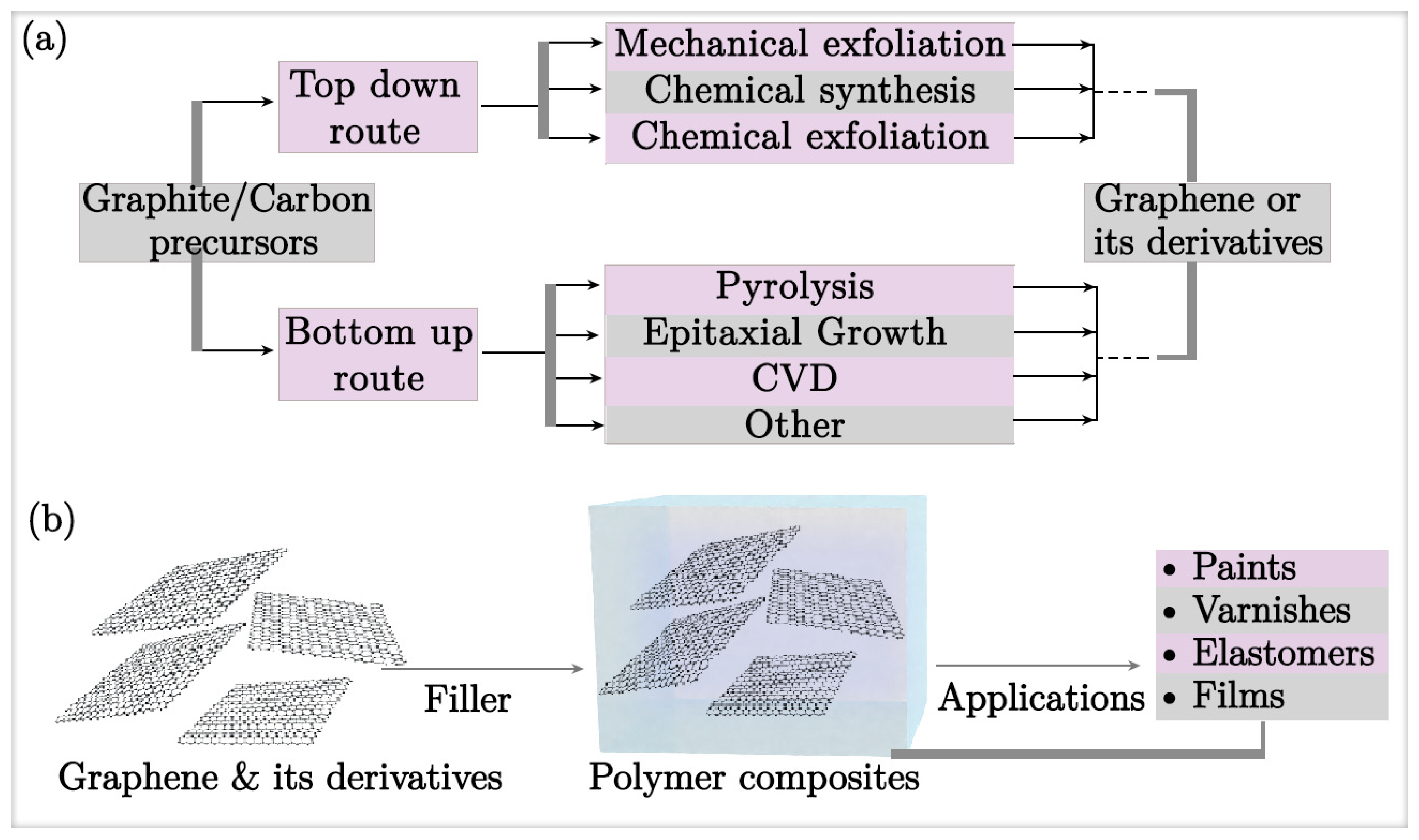
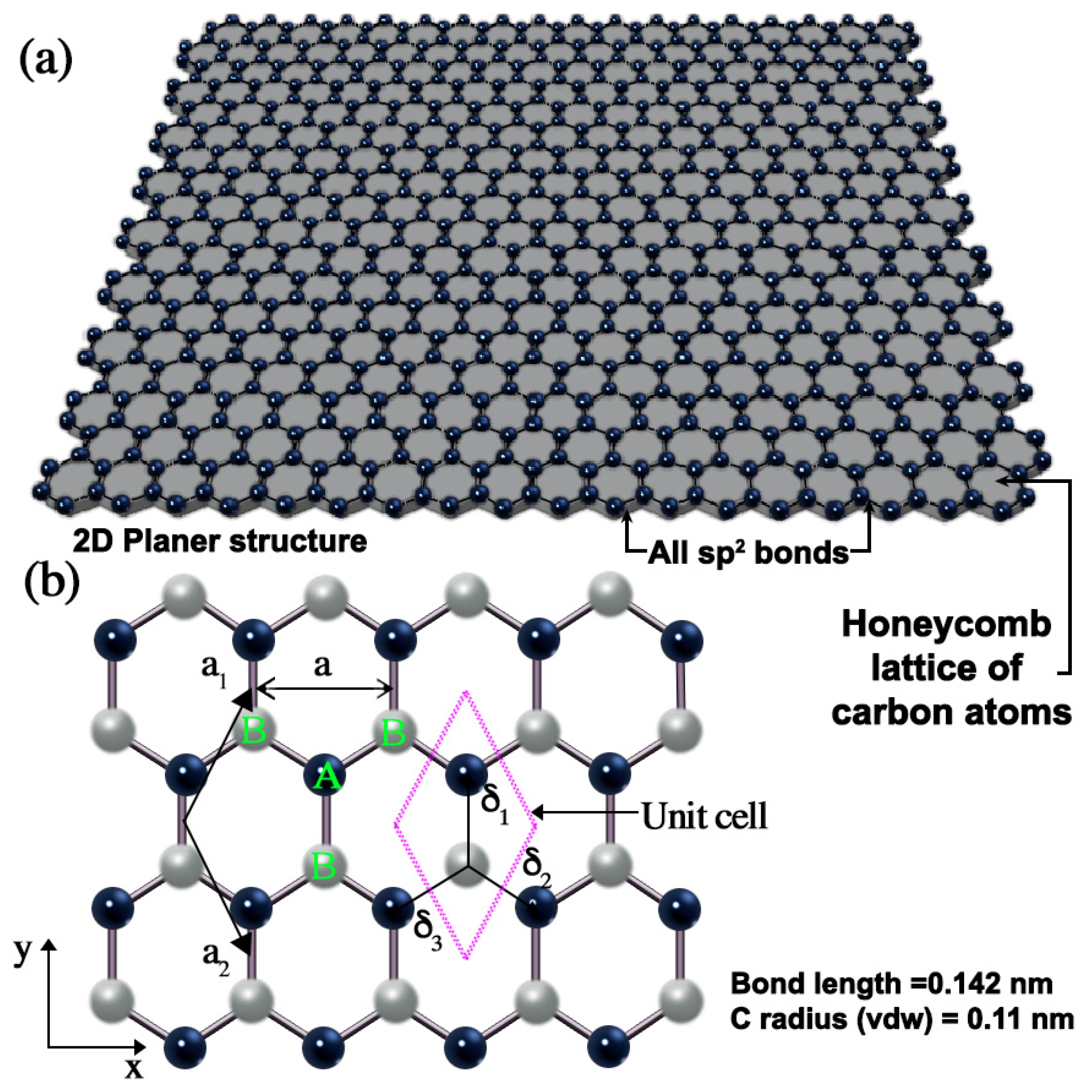

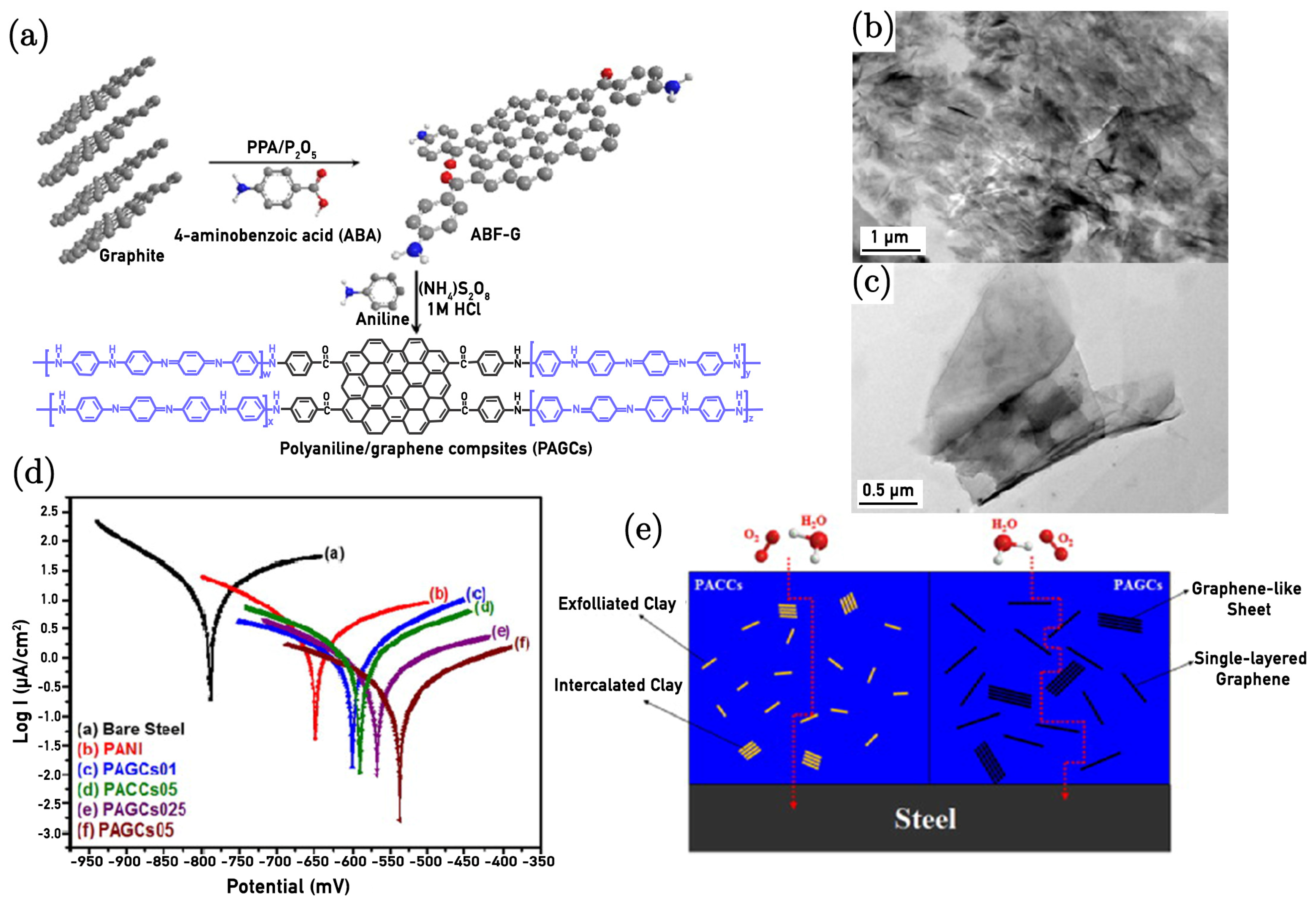

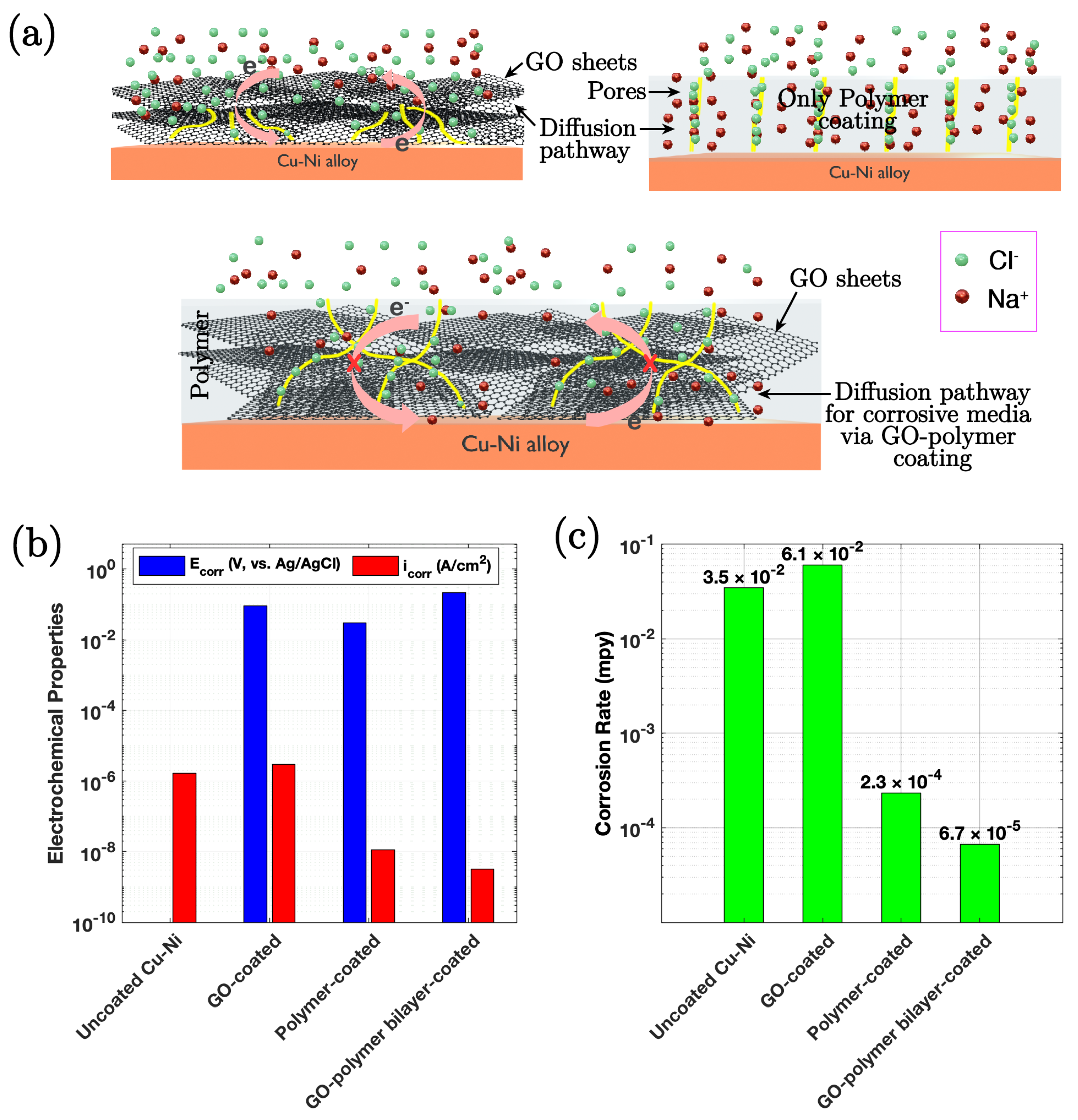
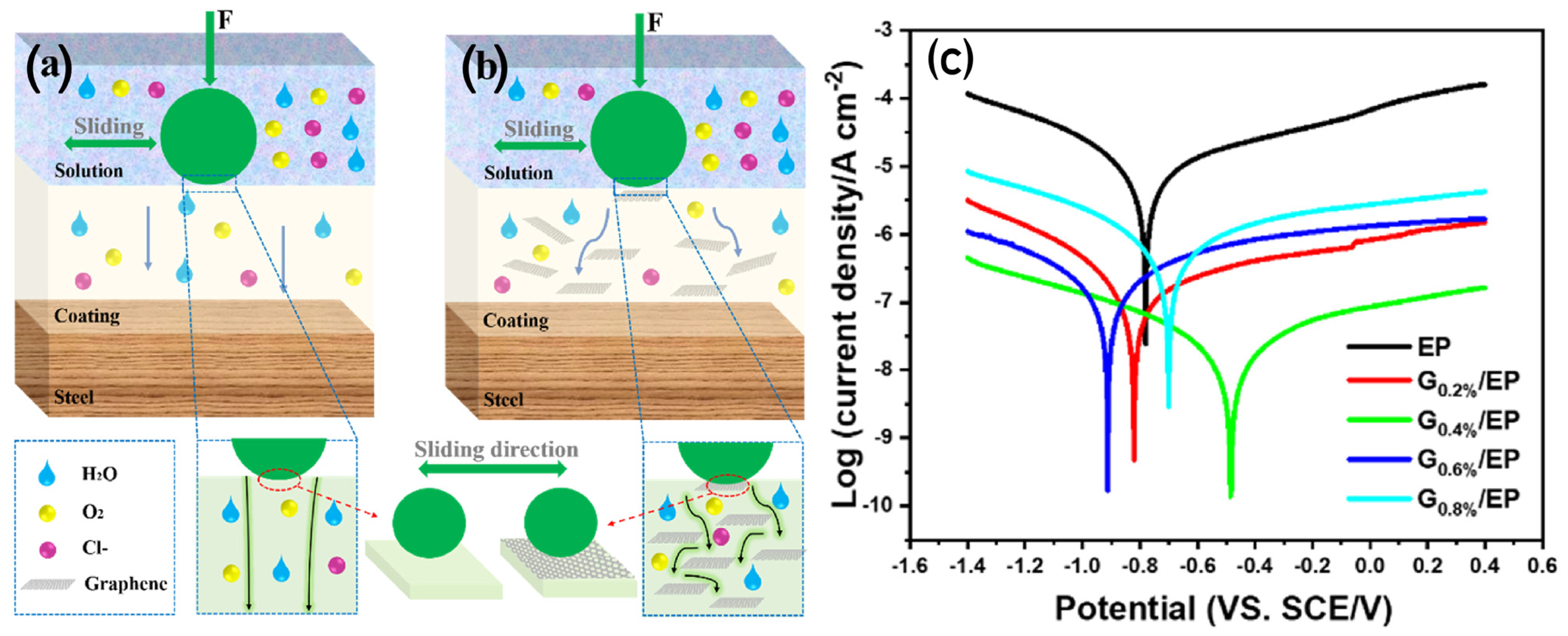
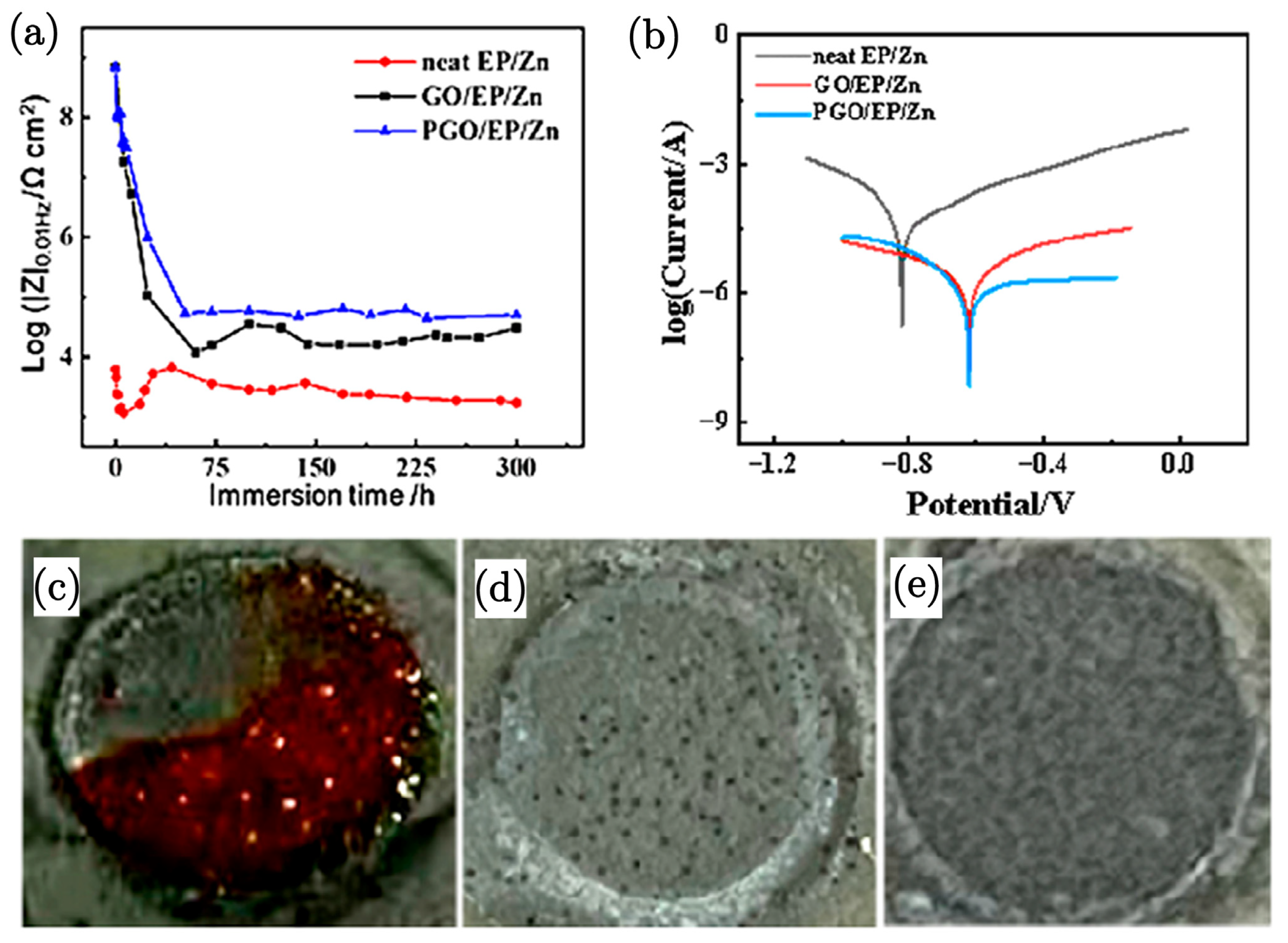
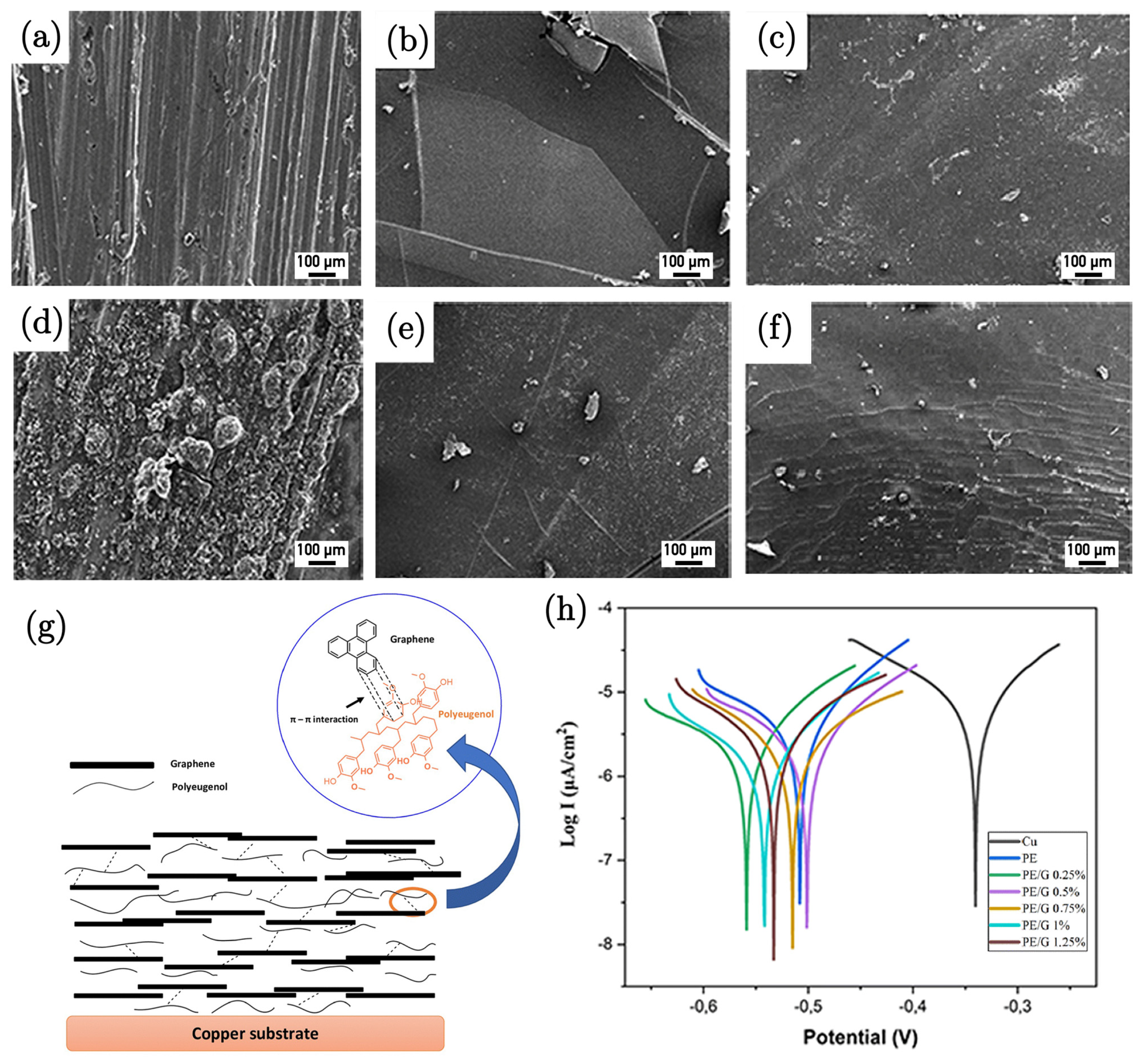
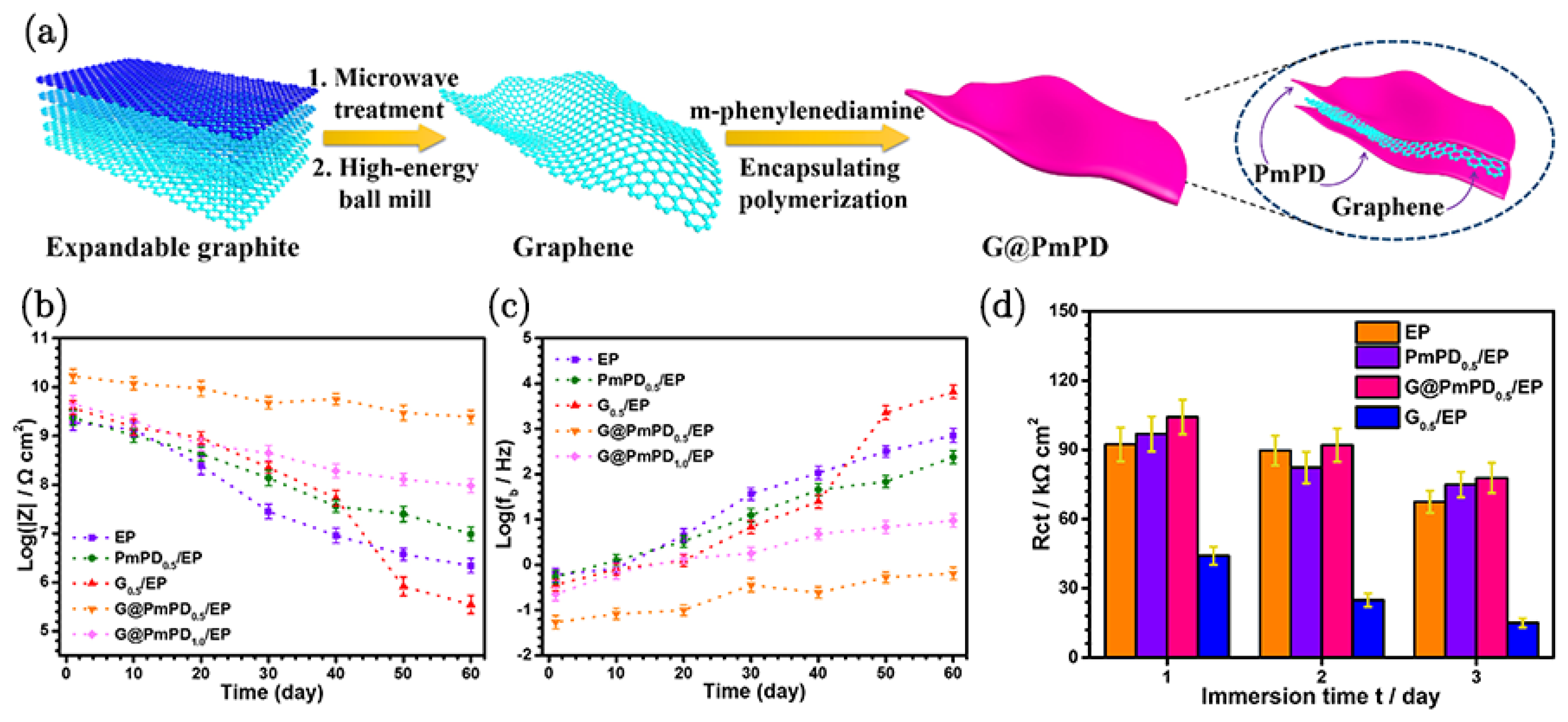
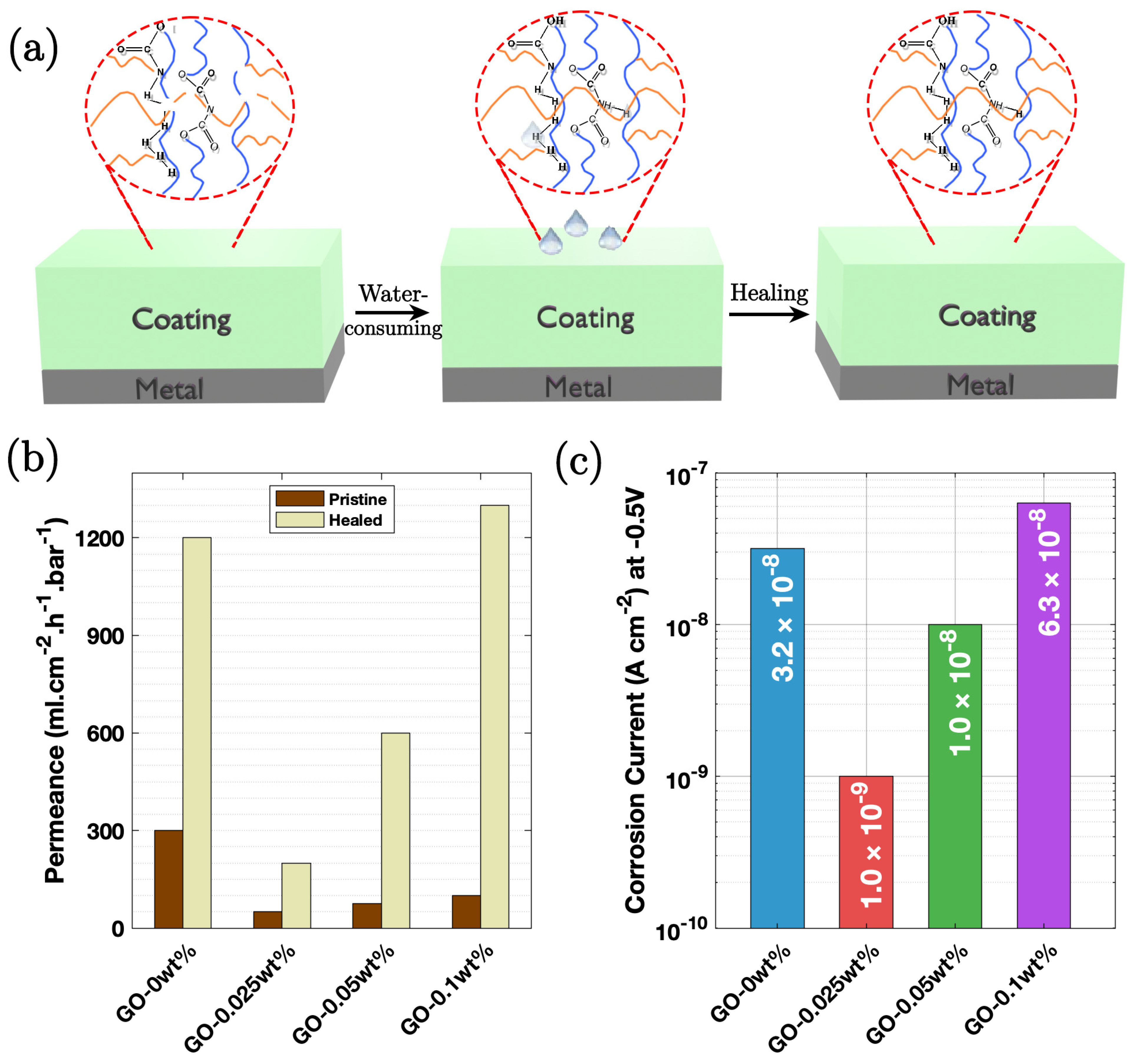
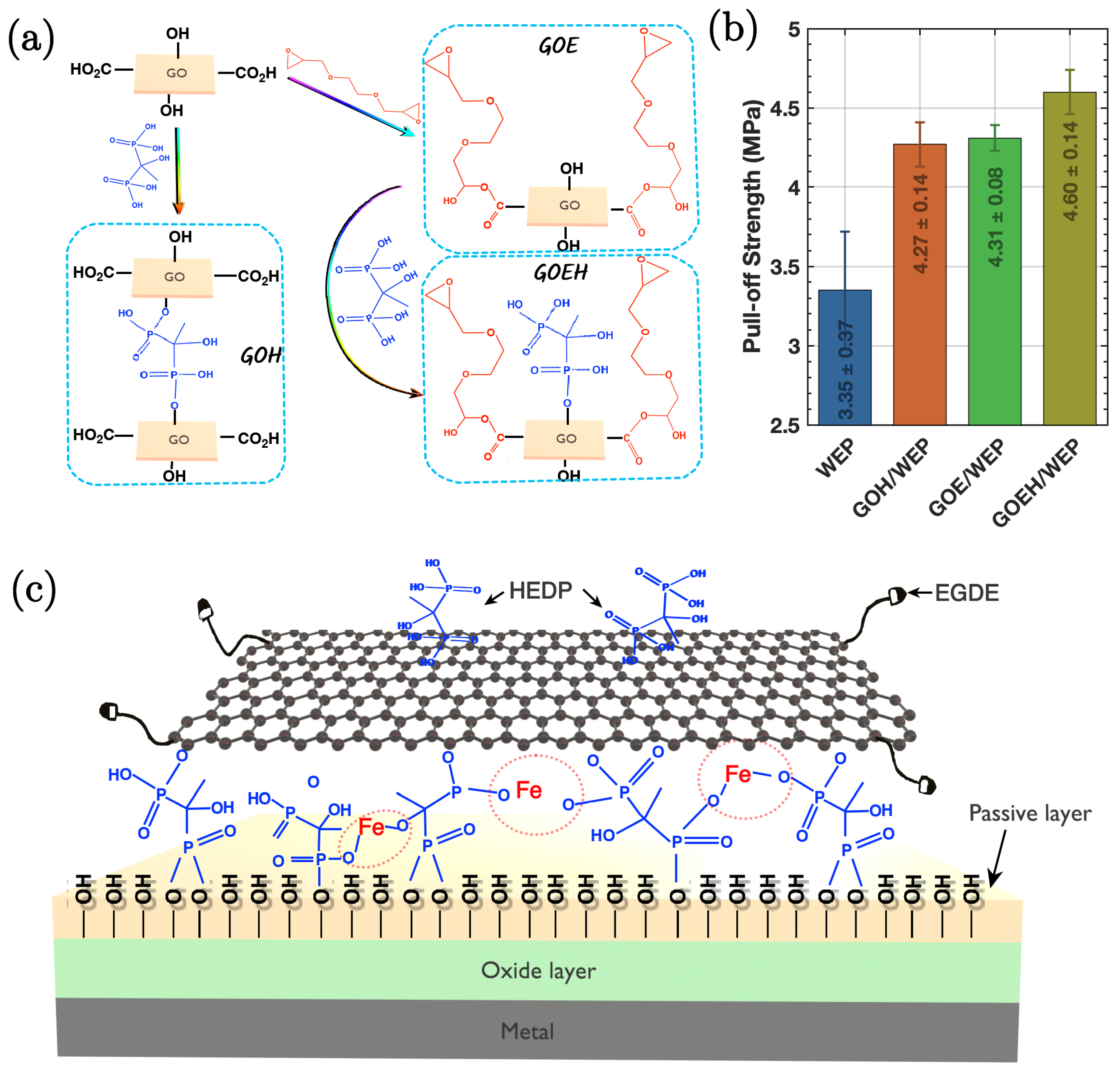
| Base Polymer | GNS Type | GNS Concentration | Fabrication Method | Observed Effect | Reference |
|---|---|---|---|---|---|
| Epoxy Resin | Graphene Oxide (GO) | 0.5 wt% | Solution Mixing | Enhanced corrosion resistance and mechanical properties | [66] |
| Polyurethane | Functionalised GO | 1.0 wt% | In situ Polymerisation | Improved barrier properties and thermal stability | [68] |
| Polyaniline | Reduced GO (rGO) | 2.0 wt% | Electrophoretic Deposition | Increased electrical conductivity and anticorrosion performance | [67] |
| Polyvinyl Alcohol | GO-Silver Nanocomposite | 0.3 wt% | Layer-by-Layer Assembly | Superior antibacterial activity and corrosion protection | [85] |
| Poly (methyl methacrylate) | GO | 0.75 wt% | Melt Blending | Enhanced UV resistance and mechanical strength | [71] |
| Material Composition | Corrosive Medium | Inhibition Efficiency (%) | Tafel Slope (βa/βc in mV/Decade) | Corrosion Current Density (Icorr, µA/cm2) | Corrosion Potential (Ecorr, V) | Ref. |
|---|---|---|---|---|---|---|
| PANI/NFGO | 3.5% NaCl | 93.5 | 95/110 | 0.12 | −0.25 | [86] |
| GO/Epoxy | 3.5% NaCl | 90.2 | 120/105 | 0.18 | −0.3 | [16] |
| rGO/Polypyrrole | 1 M HCl | 85.4 | 130/115 | 0.25 | −0.35 | [77] |
| Graphene/Polyurethane | 3.5% NaCl | 88.7 | 100/98 | 0.2 | −0.28 | [68] |
| GO/Chitosan | 0.5 M NaCl | 82.3 | 115/125 | 0.3 | −0.32 | [25] |
Disclaimer/Publisher’s Note: The statements, opinions and data contained in all publications are solely those of the individual author(s) and contributor(s) and not of MDPI and/or the editor(s). MDPI and/or the editor(s) disclaim responsibility for any injury to people or property resulting from any ideas, methods, instructions or products referred to in the content. |
© 2025 by the authors. Licensee MDPI, Basel, Switzerland. This article is an open access article distributed under the terms and conditions of the Creative Commons Attribution (CC BY) license (https://creativecommons.org/licenses/by/4.0/).
Share and Cite
Yadav, A.; Panjikar, S.; Singh Raman, R.K. Graphene-Based Impregnation into Polymeric Coating for Corrosion Resistance. Nanomaterials 2025, 15, 486. https://doi.org/10.3390/nano15070486
Yadav A, Panjikar S, Singh Raman RK. Graphene-Based Impregnation into Polymeric Coating for Corrosion Resistance. Nanomaterials. 2025; 15(7):486. https://doi.org/10.3390/nano15070486
Chicago/Turabian StyleYadav, Arti, Santosh Panjikar, and R. K. Singh Raman. 2025. "Graphene-Based Impregnation into Polymeric Coating for Corrosion Resistance" Nanomaterials 15, no. 7: 486. https://doi.org/10.3390/nano15070486
APA StyleYadav, A., Panjikar, S., & Singh Raman, R. K. (2025). Graphene-Based Impregnation into Polymeric Coating for Corrosion Resistance. Nanomaterials, 15(7), 486. https://doi.org/10.3390/nano15070486












